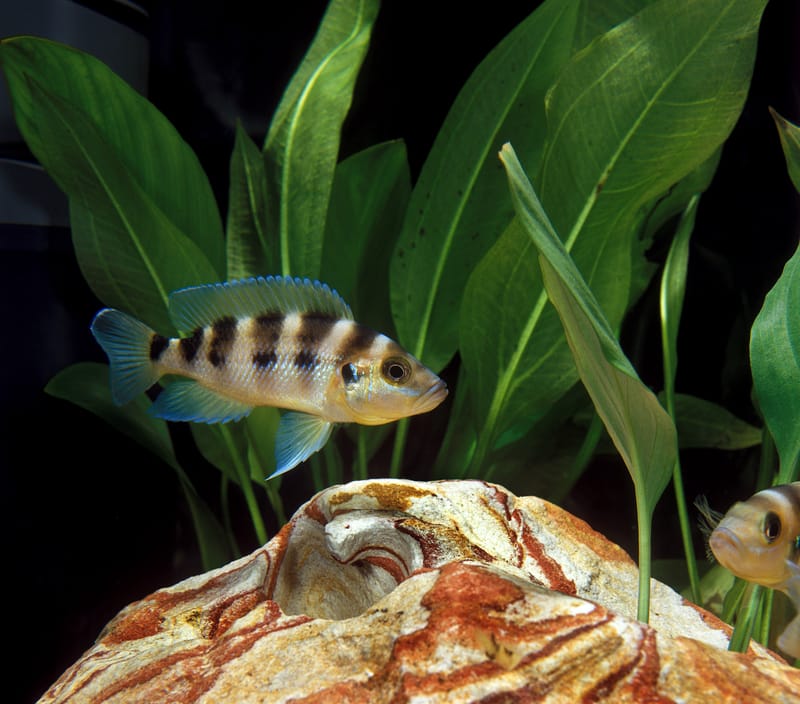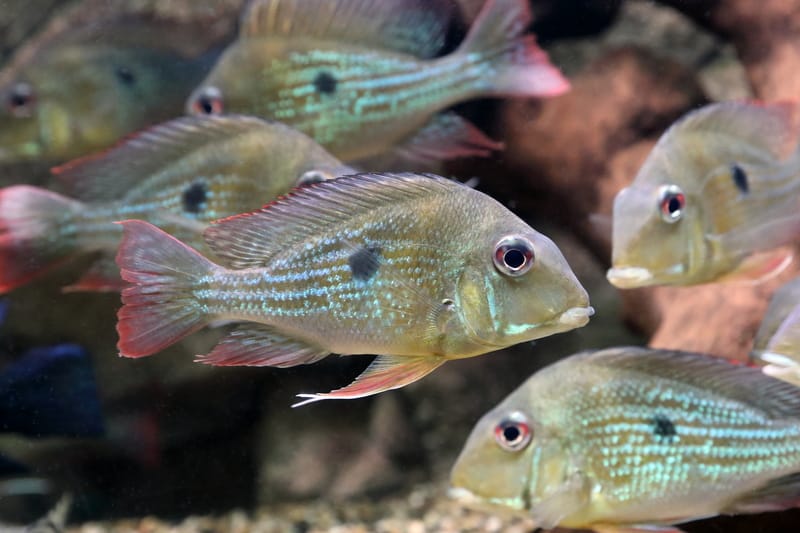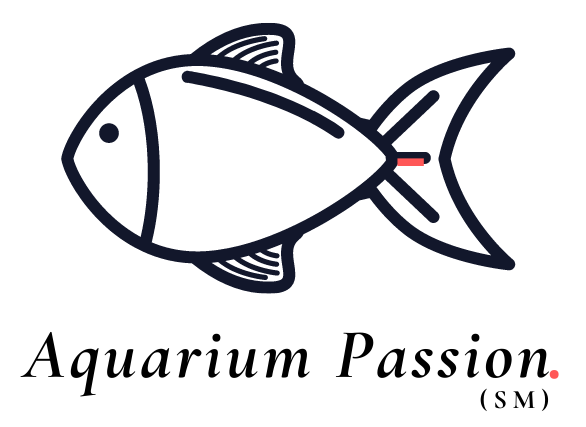12 Unique Cichlids for Your Aquarium
With over 1300 species of cichlids found around the world, there’s sure to be one that catches your eye. With their vibrant hues, these fish give your aquarium life and visual appeal.
Cichlids primarily originate from Africa and South America, with African cichlids being the more aggressive of the two. For this reason, South American cichlids are a better choice for less experienced aquarists.
Either way, you’ll need to plan your tank carefully so as to accommodate the aggressive nature of these fish. It’s worth it, though: They sure do look beautiful!
Table Of Contents
1. Chocolate Cichlid (hypselecara temporalis)
2. Silver Cichlid (vieja argentea)
3. Six Bar Cichlid (neolamprologus sexfasciatus)
4. Red Striped Earth Eater (geophagus surinamensis)
5. Yellow Lab Cichlid (labidochromis caeruleus)
6. Red chilanga (tropheus chilanga)
7. Blue-eyed tropheus (tropheus brichardi kipili)
8. Blue ahli (Sciaenochromis Ahli)
9. Three-Lined Cichlid (benthochromis tricoti)
10. Lamprologus ornatipinnis zambia
11. Red Cap Cichlid (ophthalmotilapia ventralis)
12. Cherry Spot Tropheus (tropheus bulu point)
Conclusion
Affiliate Disclosure: Some of the links on this site may be affiliate links. This means we earn a tiny commission if you make a purchase using these links. There is no additional cost to you, and we only link to products we recommend.
1 Chocolate Cichlid (hypselecara temporalis)
Scientific Name: Hypselecara temporalis
Common Name: Chocolate Cichlid, Emerald Cichlid
Originates from: South America
Water parameters: pH: 5.0-7.0, dH: up to 15 degrees. Temperature 76-86°F (24-30°C)
Behavior: Semi-Aggressive
Care difficulty level: Moderate
Appearance:
They have spherical and egg-shaped body types, and a brown-yellow coloration that is speckled. The eye’s iris can be anything from bright red to amber-gold, and the fins are various shades of red and yellow. There is typically a noticeable, substantial black mark on the fish’s flanks toward the back.
About Chocolate Cichlids:
Chocolate cichlids are perfect for decorating your aquarium. they’re friendly and generally get along well with the other fish in their aquarium, which is why they’re known as gentle giants. But these fish can get aggressive to fish that looks similar to them or belong from the same species.
In addition to being simple to maintain, these species offer color and vitality to your aquarium, making them a great fit. These fish are an excellent choice for beginners because they’re simple to care for and have no special requirements.
Packaged food is a popular and inexpensive type of fish food available in several different tastes and recipes. Below are the popular types of dried food:
2 Silver Cichlid (vieja argentea)
Scientific Name: Vieja argentea
Common Name: Silver Cichlid
Originates from: Western Mexico
Water parameters: pH: 7.0. Temperature: 78 – 86°F (26 – 30°C), Hardness: Medium hard (dH 1.0 – 15.0).
Behavior: Semi-Aggressive
Care Difficulty Level: Easy
Appearance:
The male and female members of the species feature stunning black and blue patterns along with silver/white coloring. The males also have a nuchal hump.
About Silver Cichlids:
Silver cichlids are magnificent and well-liked because of how stunning they’re. In the tank, though, they frequently chase their conspecifics. However, these species are simple to maintain, which means they’re not particularly aggressive. If you’re a beginner, you should try them.
3 Six Bar Cichlid (neolamprologus sexfasciatus)

Six Bar Cichlid Photo by © Slowmotiongli
Scientific Name: Neolamprologus sexfasciatus
Common Name: Six Bar Cichlid, Gold Sexfasciatus Cichlid
Originates from: Lake Tanganyika in East Africa
Water parameters: pH of 8.2 – 9.0, a 10 – 13° dGH, and a temperature of 77° F (25 C)
Behavior: Very aggressive
Care Difficulty Level: Easy
Appearance:
They have elongated bodies. These fish have six strong black bars on a silver-to-white-or-gold background and are relatively stocky cichlids. That is emphasized further with blue accents.
About Six Bar Cichlids:
Six-bar lamprologus have strong visual appeal. The name explains its attractiveness since sex means six, which are the striking hues of the fish. Despite their beauty, these species can become territorial and aggressive. Consequently, if you wish to keep them and add additional fish, they must be housed in a bigger tank.
4 Red Striped Earth Eater (geophagus surinamensis)

Red Striped Earth Eater Photo by © Pisotckii
Scientific Name: Geophagus surinamensis
Common Name: Red Striped Earth Eater
Originates from: South America
Water parameters: pH 6.2 to 7.6; water temperature 76 to 84 degrees F
Behavior: Peaceful
Care Difficulty Level: Easy
Appearance:
This fish is packed with colors. You can see neon green, neon blue, and red patterns on its body. Additionally, its tail and fins have a bright blue pattern and flowing design.
About Red Striped Earth Eaters:
These adorable animals are straightforward to care for, and their calm demeanor allows them to cohabit with other species. Because of this, these species are preferred by the majority of aquarists. In addition, the fish’s vibrant hues make it simple to identify them in a tank.
The greatest thing about them is that when they’re hungry, they put a lot of gravel and sand in their mouths when searching for food.
For a deep dive on this fish, check out this article.
5 Yellow Lab Cichlid (labidochromis caeruleus)
Scientific Name: Labidochromis caeruleus
Common Name: Lemon Yellow Lab, Electric Yellow Cichlid
Originates from: East Africa
Water parameters: pH around 8, Temperature: 75-82 °F and hardness 15 and 20 °H
Behavior: Semi-Aggressive
Care Difficulty Level: Easy
Appearance:
A long, golden-yellow body with fins that are dark blue-black.
About Yellow Lab Cichlids:
Another fantastic choice for aquarists is the lemon yellow lab. This species is reasonably easy to care for, and on top of all, a gorgeous fish. It stands out from other fishes by its bright hues of yellow and black.
They will, however, become hostile toward fish that are the same color or resemble them physically. Therefore, when adding lemon yellow lab to the tank, avoid keeping species of the same hue.
6 Red Chilanga (tropheus chilanga)
Scientific Name: Tropheus chilanga
Common Name: Red Chilanga
Originates from: Lake Tanganyika in East Africa
Water parameters: ph level around 8.0 to 8.6 and temperature 77 – 79°F
Behavior: Very Aggressive
Care Difficulty Level: Hard
Appearance:
They grow up to 14 cm, and its color is a mixture of blackish red and orange.
About Red Chilangas:
The red chilanga is well-liked among hobbyists. However, some aquarists find it difficult to retain these fish due to their highly aggressive behavior. To help spread out aggression, you should keep these fish in groups of twelve or more. Nevertheless, these fish’s excitement at feeding time and stunning colors are what make them hobbyists’ favorites.
7 Blue-Eyed Tropheus (tropheus brichardi kipili)
Scientific Name: Tropheus brichardi kipili
Common Name: Kipili, Blue-Eyed Tropheus
Originates from: East Africa
Water parameters: pH: 8.6 and Temperature: 77 – 79°F
Behavior: Semi-Aggressive
Care Difficulty Level: When its food is carefully monitored, and the required water changes are performed, keeping this hardy cichlid can be simple.
Appearance:
Eye iris coloration can change to blue. This species comes in various shapes and colors, and these fish’s vertical stripes are their defining feature.
About Blue-Eyed Tropheus:
The kipili has become another popular fish among aquarists because of its wide range of colors. A colony of 12 to 30 of these fish may put on a fantastic display. They’re desired because of their active behavior. However, these fishes can get aggressive, depending on their mood.
8 Blue Ahli (sciaenochromis ahli)

Electric Blue Hap Photo by © Tatiana Belova
Scientific Name: Sciaenochromis ahli
Common Name: Blue Ahli, Electric Blue Hap
Originates from: Lake Malawi, Africa
Water parameters: ph between 7.6-8.8 and temperature 75-82° F (23.9-27.8° C)
Behavior: Very Aggressive
Care Difficulty Level: Easy
Appearance:
Long body, big eyes, large mouth, and plump lips, bright metallic blue in color. With body sides covered with transverse dark stripes.
About Blue Ahlis:
The blue ahli, a fish with stunning colors and extreme beauty, is a wonderful addition to the tank. Their distinctive tint illuminates the tank’s look. However, they’re reputed to be quite violent and aggressive. Therefore most people refrain from retaining them.
But, if they have a lot of hiding spots, you may keep them in the tank. Male blue Ahli are the most aggressive; therefore, it’s best to avoid them. However, if you want to, you may add one male fish to three female fish.
9 Three-Lined Cichlid (benthochromis tricoti)
Scientific Name: Benthochromis tricoti
Common Name: Three-Lined Cichlid
Originates from: Lake Tanganyika in Africa
Water parameters: ph level from 7.9 to 8.6, and temperature 25-27° C, hardness dH 15-25°
Behavior: Peaceful
Care Difficulty Level: Moderate
Appearance:
Large eyes and a lengthy body. Males have lengthened fins and a beautiful coloring that includes silver, purple, and turquoise, while females are silver-grey. The fish also has two lateral lines visible on it.
About Three-Lined Cichlids:
Benthochromis tricoti is a rather large and attractive schooling cichlid. And putting it in your tank will entirely transform how it appears. Since they’re shoaling, you may keep them together in groups or pair them with other peaceful cichlid species.
10 Lamprologus Ornatipinnis Zambia
Scientific Name: Lamprologus ornatipinnis
Common Name: None
Originates from: Lake Tanganyika in Africa
Water parameters: pH 7.5-8.6, Temperature: 77 – 79°F
Behavior: Semi-Aggressive
Care Difficulty Level: Easy
Appearance:
Their bodies are thin and long with opalescent scales, and their fins sport beautiful white spots.
About Lamprologus Ornatipinnis Cichlids:
Lamprologus ornatipinnis is a worthwhile addition to your tank because of its anti-territorial tendencies and lack of aggression. Not only this, but its distinct beauty catches everyone’s attention and makes them desire to own it.
11 Red Cap Cichlid (ophthalmotilapia ventralis)

Male Red Cap Cichlid Photo by © Guinapora
Scientific Name: Ophthalmotilapia ventralis
Common Name: Red Cap Cichlid
Originates from: Lake Tanganyika in Africa
Water parameters: pH 7.5-9.0, Temperature: 73-81°F (23-27°C) and Hardness: 8-25°H
Behavior: Peaceful, but territorial when spawning
Care Difficulty Level: Moderate
Appearance:
While females have delicate green with a metallic gloss, men have a steel blue hue. Moreover, there is a color variant known as the orange cap, which has an orange-brown appearance on the head.
About Red Cap Cichlids:
These lovely fish are usually calm and kept only in a species aquarium. If they’re among other fish who share their appearance, they may become hostile. They can also grow aggressive if their water is not changed and they’re not adequately cared for. Other than that, nothing else triggers them. However, as male fish tend to show off their best colors, you’ll notice even better colors if you maintain one in a female tank.
12 Cherry Spot Tropheus (tropheus bulu point)
Scientific Name: Tropheus bulu point
Common Name: Cherry Spot Tropheus, Tropheus Kirschfleck
Originates from: Lake Tanganyika in Africa
Water parameters: pH 8.0-9.0, temperature 24-27 Deg C / 74-79 Deg F
Behavior: Very Aggressive
Care Difficulty Level: Moderate
Appearance:
Males often have a turned-up nose and a deeper physique. In contrast, females have thin, stream-lined body with a nose that is rounded and sloping. Two sizable red or golden spots are on either side of their black bodies.
About Cherry Spot Tropheus:
Cherry Spot Tropheus is one of my favorites, along with the species already listed. These sweet species make lovely additions to your aquarium. But remember that male tropheus are pretty aggressive and frequently intimidate female fish. Therefore, preserving one male per trio of female fish is recommended. To avoid conflict, always add them in groups of ten or more.
13 Conclusion
Did you choose the one you’re keeping in your tank? I know I did!
The sheer variety that cichlids provide us when it comes to choosing between them is a delight. They’re lovely to watch, giving your aquarium so much personality and color that you can create a visually arresting seascape.
There are many different species of cichlids, many of which have attractive colors and characters. Remember that most cichlids are either semi-aggressive or very aggressive, so you must plan your tank mindfully to make sure they have suitable tank mates!
